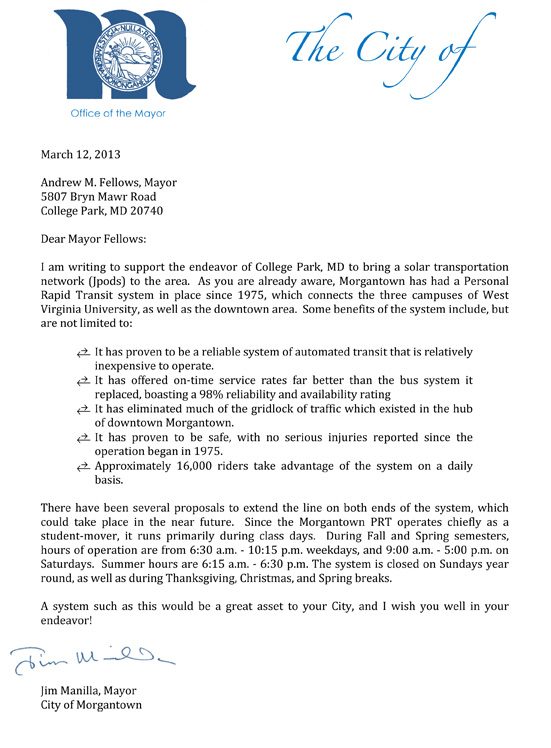Morgantown’s PRT: Solution to Peak Oil, Climate Change, Debt
We have known the solution known the solution to urban traffic problems, rising oil prices, and Climate Change for half a century. Yet Federal regulations block such innovations.
President Nixon sent his daughter, Tricia, to open the world’s first electrically powered, grade-separated network of self-driving cars in Oct, 1972. Walter Cronkite opened the news coverage with, “One of the big problems in this country is something many of us run into every day, traffic jams.” Tricia Nixon said it was “more fun than Disneyland.”
It was part of his plan for the environment and energy. He would later state the objective, “At the end of this decade, in the year 1980, the United States will not be dependent on any other country for the energy we need. We will hold our future in our hands alone.”
This network is still operating today with outstanding success as noted by the Mayor of Morgantown in this 2013 letter:

JPods US Patent improves on the Morgantown PRT in two important ways (6,810,817):
- Robots replace the central computer control system: “A method of controlling a transportation System for moving people, freight, and any combination whereof using a distributed network of intelligent devices without requiring the aid of a human driver”
- Networks are solar-powered: “The method… providing… Solar and wind power generators integrated into the physical Structure of Said transportation System….”
Congressional Study: Barriers to Innovation, government “institutional failures”
The barrier expanding these networks beyond Morgantown is government regulations as documented in Congressional Study PB-244854, “Automated Guideway Transit”, 1975. These same government “institutional failures” caused of 46% of 470 ton-mpg freight railroads to be replaced by roads with the 25 mpg efficiency of the Model-T.

5X5 Standard to Correct “institutional failures”
Morgantown’s PRT is self-regulated so it does not provide a viable model to be replicated. The 5X5 Standard of the Solar Mobility Agreement was created to provide a fundable regulatory framework. It as been successfully negotiated with cities and signed in the US and China (link). It is a relatively simple standard that grade-separated transport networks 5 times more efficient than roads pay 5% of gross transportation revenues to use the airspace over roads to build networks.
Summary:
- West Virginia University Transportation site.
- 110 million injury-free passenger-miles. In the same period, 1.7 million Americans were road-killed.
- Pays for itself every 5 years, independent audit in 2010.
- Congressional Office of Technology Assessment study (COTA 1974) PB-244854, a solution for American cities to be independent of foreign oil.
- Link to one-minute video of Morgantown’s PRT.
- Link to 17-minute, 1977 video of the benefits experienced since PRT opened in 1975.
- THE ROAD NOT TAKEN, How we found (and lost) the dream of Personal Rapid Transit
Morgantown PRT opened in 1975 and has delivered 110 million injury-free passenger miles. By all accounts, the Morgantown PRT has been an absolute success. Link to a 1977 video of that success two years after the PRT opened. Below is a letter from the Mayor or Morgantown explaining the benefits PRT has provided to his city.
In response to the 1973 Oil Embargo, the US Senate asked DOT for mobility solutions to prevent hardships in future embargoes. The Office of Technology Assessment provided an answer to the Senate Committee on Appropriations in Automated Guide Ways and Personal Rapid Transit (PB-244854). An independent audit in 2010 indicates the network pays for itself every 5 years. The Office of Technology Assessment study resulted in the conclusion that “PRT has the highest potential service level and may have the highest patronage level of all AGT [Automated Guideway Transit] systems.” The also study accurately predicted what would be its own failings:
- Federally sponsored R & D has not included a coordinated program for conversion of successful products into operational systems.
- UMTA’s R&D programs [US DOT Urban Mass Transit Administration]… have neglected near-term … simpler approaches to correct transit problems.
- Finally, institutional failures may have hindered implementation.
Link to 1977 Morgantown PRT video.
Link to 21 Presidential veto message that document Federal taxing to fund “internal improvements” is unconstitutional.
Denver’s Federal grant for PRT in 1970.






